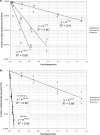Inactivation of poxviruses by upper-room UVC light in a simulated hospital room environment
- PMID: 18781204
- PMCID: PMC2527528
- DOI: 10.1371/journal.pone.0003186
Inactivation of poxviruses by upper-room UVC light in a simulated hospital room environment
Abstract
In the event of a smallpox outbreak due to bioterrorism, delays in vaccination programs may lead to significant secondary transmission. In the early phases of such an outbreak, transmission of smallpox will take place especially in locations where infected persons may congregate, such as hospital emergency rooms. Air disinfection using upper-room 254 nm (UVC) light can lower the airborne concentrations of infective viruses in the lower part of the room, and thereby control the spread of airborne infections among room occupants without exposing occupants to a significant amount of UVC. Using vaccinia virus aerosols as a surrogate for smallpox we report on the effectiveness of air disinfection, via upper-room UVC light, under simulated real world conditions including the effects of convection, mechanical mixing, temperature and relative humidity. In decay experiments, upper-room UVC fixtures used with mixing by a conventional ceiling fan produced decreases in airborne virus concentrations that would require additional ventilation of more than 87 air changes per hour. Under steady state conditions the effective air changes per hour associated with upper-room UVC ranged from 18 to 1000. The surprisingly high end of the observed range resulted from the extreme susceptibility of vaccinia virus to UVC at low relative humidity and use of 4 UVC fixtures in a small room with efficient air mixing. Increasing the number of UVC fixtures or mechanical ventilation rates resulted in greater fractional reduction in virus aerosol and UVC effectiveness was higher in winter compared to summer for each scenario tested. These data demonstrate that upper-room UVC has the potential to greatly reduce exposure to susceptible viral aerosols. The greater survival at baseline and greater UVC susceptibility of vaccinia under winter conditions suggest that while risk from an aerosol attack with smallpox would be greatest in winter, protective measures using UVC may also be most efficient at this time. These data may also be relevant to influenza, which also has improved aerosol survival at low RH and somewhat similar sensitivity to UVC.
Conflict of interest statement
Figures



Similar articles
-
Characterization of UVC light sensitivity of vaccinia virus.Appl Environ Microbiol. 2007 Sep;73(18):5760-6. doi: 10.1128/AEM.00110-07. Epub 2007 Jul 20. Appl Environ Microbiol. 2007. PMID: 17644645 Free PMC article.
-
The characterization of upper-room ultraviolet germicidal irradiation in inactivating airborne microorganisms.Environ Health Perspect. 2002 Jan;110(1):95-101. doi: 10.1289/ehp.0211095. Environ Health Perspect. 2002. PMID: 11781170 Free PMC article.
-
Turn Up the Lights, Leave them On and Shine them All Around-Numerical Simulations Point the Way to more Efficient Use of Far-UVC Lights for the Inactivation of Airborne Coronavirus.Photochem Photobiol. 2022 Mar;98(2):471-483. doi: 10.1111/php.13523. Epub 2021 Oct 23. Photochem Photobiol. 2022. PMID: 34599612 Free PMC article.
-
Air Disinfection for Airborne Infection Control with a Focus on COVID-19: Why Germicidal UV is Essential†.Photochem Photobiol. 2021 May;97(3):493-497. doi: 10.1111/php.13421. Epub 2021 Apr 5. Photochem Photobiol. 2021. PMID: 33759191 Free PMC article. Review.
-
COVID-19 pandemic lesson learned- critical parameters and research needs for UVC inactivation of viral aerosols.J Hazard Mater Adv. 2022 Nov;8:100183. doi: 10.1016/j.hazadv.2022.100183. Epub 2022 Oct 12. J Hazard Mater Adv. 2022. PMID: 36619826 Free PMC article. Review.
Cited by
-
Capacity Models and Transmission Risk Mitigation: An Engineering Framework to Predict the Effect of Air Disinfection by Germicidal Ultraviolet Radiation.J Res Natl Inst Stand Technol. 2022 Mar 21;126:126057. doi: 10.6028/jres.126.057. eCollection 2021. J Res Natl Inst Stand Technol. 2022. PMID: 39359736 Free PMC article.
-
Role of viral bioaerosols in nosocomial infections and measures for prevention and control.J Aerosol Sci. 2018 Mar;117:200-211. doi: 10.1016/j.jaerosci.2017.11.011. Epub 2017 Dec 2. J Aerosol Sci. 2018. PMID: 32226118 Free PMC article. Review.
-
Upper-room ultraviolet air disinfection might help to reduce COVID-19 transmission in buildings: a feasibility study.PeerJ. 2020 Oct 13;8:e10196. doi: 10.7717/peerj.10196. eCollection 2020. PeerJ. 2020. PMID: 33083158 Free PMC article.
-
UVC-based photoinactivation as an efficient tool to control the transmission of coronaviruses.Sci Total Environ. 2021 Oct 20;792:148548. doi: 10.1016/j.scitotenv.2021.148548. Epub 2021 Jun 16. Sci Total Environ. 2021. PMID: 34465056 Free PMC article. Review.
-
The impact of heating, ventilation, and air conditioning design features on the transmission of viruses, including the 2019 novel coronavirus: A systematic review of ultraviolet radiation.PLoS One. 2022 Apr 8;17(4):e0266487. doi: 10.1371/journal.pone.0266487. eCollection 2022. PLoS One. 2022. PMID: 35395010 Free PMC article.
References
-
- Henderson DA, Inglesby TV, Bartlett JG, Ascher MS, Eitzen E, et al. Smallpox as a biological weapon: medical and public health management. Working Group on Civilian Biodefense. Jama. 1999;281:2127–37. - PubMed
-
- Xu P, Peccia J, Fabian P, Martyny JW, Fennelly KP, et al. Efficacy of ultraviolet germicidal irradiation of upper-room air in inactivating airborne bacterial spores and mycobacteria in full-scale studies. Atmospheric Env. 2003;37:405–419.
-
- Xu P, Kujundzic E, Peccia J, Schafer MP, Moss G, et al. Impact of environmental factors on efficacy of upper-room air ultraviolet germicidal irradiation for inactivating airborne mycobacteria. Environ Sci Technol. 2005;39:9656–64. - PubMed
Publication types
MeSH terms
Substances
Grants and funding
LinkOut - more resources
Full Text Sources
Medical

